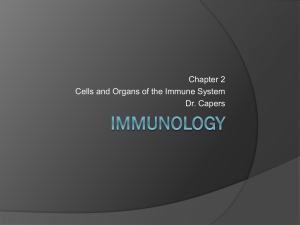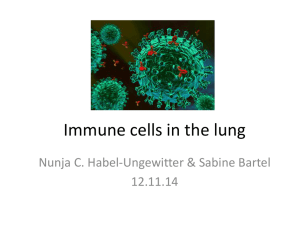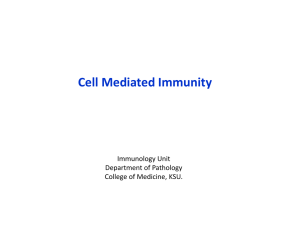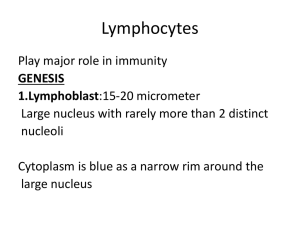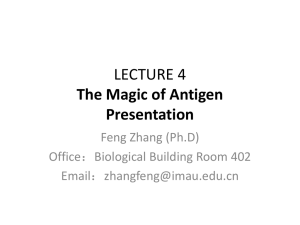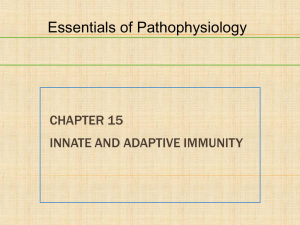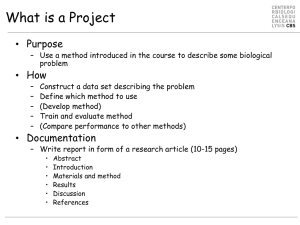T cells
advertisement
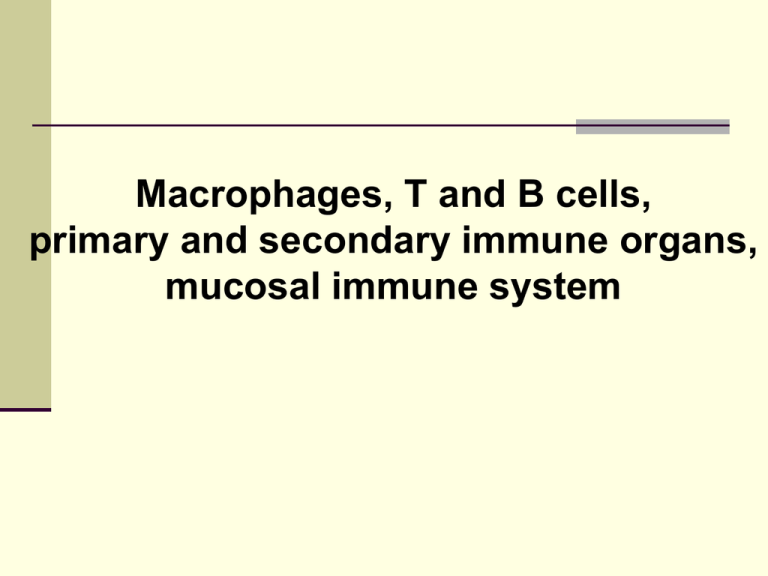
Macrophages, T and B cells, primary and secondary immune organs, mucosal immune system Macrophages Terminal stage of monocyte-macrophage line differentiation Monocyte-macrophage cells differentiate from myeloid precursor (developed from pluripotent stem cell bearing CD34) in bone marrow Matured monocytes are released to peripheral blood stream, then move in organs and develop into tissue macrophages Development of monocytes and macrophages is affected by various cytokines: SCF(stem cell factor): produced by stromal cells → activation of stem cell GM-CSF (granulocyte-monocyte colony stimulating factor): produced by bone marrow (BM) stromal cells, lymphocytes → stimulation of monocyte production M-CSF (monocyte colony stimulating factor): produced by stromal cells, lymphocytes, endothelial and epithelial cells → production and maturation of monocytes IL-3: produced by lymphocytes → production of monocytes (and other blood cells) Macrophages- development Monocytes- in the blood (7%) and the rest in bone marrow Macrophages - in tissues histiocytes Macrophages a monocyte enter damaged tissue through the endothelium of a blood vessel a monocyte is attracted to damaged site by chemokines, triggered by stimuli including damaged cells, pathogens and cytokines released by macrophages after migration of monocytes to the tissues, they differentiate into different forms of macrophages macrophages survive several months Macrophage surface molecules MHC gp I, II assist in the presentation of antigen to T lymphocytes CD 35 - complement receptor 1 (CR 1), binds complement C3b Receptor for the Fc portion of IgG CD 14 - receptor for bacterial lipopolysaccharides Cytokines produced by macrophages IL- 1 α, ß - stimulate both T and B cells, Ig synthesis, activation of other macrophages, sensitizing cells to IL-2 and IFN TNF- α - similar in function to IL-1 IL- 8 - secreted by activated macrophages - chemokine attracting neutrophils and T cells IL-12 - promotes induction of Th1 cells, inhibits Th2 cells IFN- α- activates host cells to induce enzymes inhibiting viral replication; increases expression of MHC gp I on host cells; activates NK cells, T cells, other macrophages Functions of macrophages Phagocytosis Production of cytokines Presentation of epitops with MHC gp II Presentation of epitops with MHC gp I Phagocytosis a foreign substances are ingested microbes are killed and digested follows processing of antigenic epitopes and their presentation on the cell membrane Macrophage - functions Macrophages provide defense against tumor cells and human cells infected with fungi or parasites. T cell becomes an activated effector cell after recognition of an antigen on the surface of the APC → release chemical mediators → stimulation of macrophages Presentation of epitopes with MHC gp II After endocytosis and degradation of the antigen, presentation of its epitopes follows epitope is connected to MHC gp II → cell surface → presentation to Th cells MHC (Major Histocompatibility Complex) = complex of genes that governs the production of the major histocompatibility antigens - in humans termed HLAs (Human Leukocyte Antigens) Presentation epitopes with MHC gp I intracellular parasites are hydrolyzed in proteasomes of macrophages their peptides are connected to TAP (Transporters Associated with antigen Processing molecules 1,2), that carry the epitope and MHC gp I → presentation on the cell surface to Tc cells Antigen presentation Dendritic Cells (DC) DC mature after a contact with pathogen, then migrate to lymph nodes where antigen-specific immune response develops DC are equipped with numerous cytoplasmic processes, allowing contact with up to 3000 T cells In lymph nodes, the expression of MHC gp I and co- stimulatory molecules (CD80, CD86) on DC increases Types of Dendritic Cells Myeloid DC – similar to monocytes – give rise to Langerhans cells (epidermis), interticial DC (lymph nodes) Lymphoid DC – give rise to plasmocytoid DC - looks like plasma cells, but have certain characteristics similar to myeloid cells, they produce huge amounts of interferons Function of DCs DCs are the most important APC DCs can be easily infected by viruses → processing of viral proteins → their presentation in complex with MHC gp I → activation of Tc DCs can ingest extracellular viral particles → their presentation in complex with MHC gp II → activation of Th2 cells → help for B cells → production of antiviral antibodies DCs can also be activated by apoptotic cells Antigen Presenting Cells (APC) Dendritic cells, macrophages, B cells Antigen processing and its presentation to T cells in the complex with HLA class I or II Providing additional signals to T cells which are necessary for their activation (CD 80, CD 86) T cells: ontogenesis, surface markers. Subpopulations of T cells and their functions. T lymphocytes - ontogenesis Stem cell in BM gives rise to lymphoid precursor cell which matures into 3 types of lymphocytes: T lymphocytes B lymphocytes Natural killer (NK) cells Pro-thymocytes move to the thymus where continue the maturation into T lymphocytes Maturation of B lymphocytes continues in BM Surface markers of T cells CD (Cluster of Differentiation) proteins - molecules on the cells membrane, they allow the identification of cells TCR - receptor for antigen MHC gp I CD proteins allow an identification of T-cell subsets CD 2 = adhesion molecule CD 3 = important in intracellular signaling (initiation of immune response); closely associated with TCR CD 5,7 CD 4,8 = are expresed on subclasses of mature T cells; CD4 reacts with MHC gp II,CD8 reacts with MHC gp I on macrophages CD 28 – molecule that provides co-stimulatory signals, binds CD80 and 86 Maturation of T lymphocytes Consist of three types of processes: Proliferation of immature cells Expression of antigen receptors genes Selection of lymphocytes TCR Antigen receptors are encoded by several gene segments that recombine during lymphocyte maturation Heterodimer consisting of 2 nonidentical polypeptide chains linked together by disulfide bonds > 95% T cells express the αß heterodimer, 5% γδ TCR heterodimer is noncovalently associated with the γ,δ,ε chains of the CD3 molecule complex TCR-CD3 makes contact with both the Ag and MHC gp Subpopulation of T cells Subpopulation of T cells are defined according to their particular function and their CD membrane markers T cytotoxic cells (Tc) CD8+ - recognize the foreign epitope in association with class I MHC molecules T helper cells (Th) CD4+ - recognize the epitopes in association with class II MHC molecules T cytotoxic lymphocytes (Tc;CD8+) cause lysis of target cell; active against tumors, virus- infected cells, transplanted allogeneic tissue release TNF → decrease of proteosynthesis recognize the foreign epitope in association with MHC gp I molecules Destroy target cells by perforins (create pores in the cell membrane → cell lysis) and granzymes (degradation of essential macromolecules) T helper lymphocytes (Th; CD4+) recognize the epitopes in association with MHC gp II help for B cells to produce antibodies and help for phagocytes to destroy ingested microbes subsets of Th cells: Th1, Th2 cells Regulatory T cells Express CD4, CD25, FoxP3 Regulate the activation or effector function of other T cells Are necessary to maintain tolerance to self antigens Production of IL-10, TGF-b The role of thymus. Positive and negative selection of T lymphocytes. The role of thymus In thymus, lymphocyte precursors from the bone marrow become thymocytes, and subsequently mature into T cells Once matured, T cells migrate from the thymus and constitute the peripheral T cell repertoire responsible for specific cell response Phases of thymocyte maturation A rare population of hematopoietic progenitors enters the thymus from the blood, and expands to a large population of immature thymocytes Immature thymocytes each produce distinct T cell receptors by a process of gene rearrangement. This process is error-prone, and some thymocytes fail to make functional T cell receptors, whereas other thymocytes make T cell receptors that are autoreactive Positive and negative selection Immature thymocytes undergo a process of selection, based on the specificity of their T cell receptors. This involves selection of T cells that are functional (positive selection), and elimination of T cells that are autoreactive (negative selection) Positive selection of T cells Entrance of precursor T cells into thymus from the blood 2. Presentation of self-antigens in complexes with MHC molecules on the surface of cortical epithelial cells to thymocytes 3. Only those thymocytes which bind the MHC/antigen complex with adequate affinity will receive a vital "survival signal" 4. The other thymocytes die (>95%) 1. Negative selection of T cells 1. Thymocytes that survive negative selection migrate towards the thymic cortex and medulla 2. Presentation of self-antigen in complex with MHC molecules on antigen-presenting cells 3. Thymocytes that react inappropriately strongly with the antigen receive an signal of apoptosis B-lymphocytes - ontogenesis, surface markers, function. B-lymphocytes are an essential component of the adaptive immune system Maturation of B cells takes place in BM B cell originates from stem cell and need to be in touch with the stromal cells in the bone marrow Stromal cells produce SCF (stem cell factor) necessary for development at early period, IL-7 necessary at later period of maturation Ig gene rearrangements and the appearance of surface markers identify the stage of B-cell development Development of B lymphocytes Lymphoid progenitor → pro-B cells During maturation from pro-B cells into pre-B cells: Ig genes of the heavy chain recombine; pre-B cells express pre-BCR During maturation from pre-B cells into B cells: Ig genes of the light chain recombine Immature B cells express membrane IgM Mature B cells express membrane IgM and IgD = BCR and are able to respond to antigen in peripheral lymphoid tissues Negative selection If an immature B cell binds an antigen in the bone marrow with high affinity → further maturation is stopped and B cell dies by apoptosis Negative selection eliminates potentially dangerous cells that can recognize and react against self antigens B cells that survive this selection process leave the bone marrow through efferent blood vessels B-lymphocytes – surface markers CD 10 - immature B cells, malignant cells CD 35 - receptor for the C3b of the complement CD 19 - characteristic marker of B cells CD 20 - typical surface antigen of Ig-positive B lymphocytes IgM, IgD - antigen receptors = BCR MHC gp II - antigen-presenting molecules B-lymphocytes – functions After stimulation B lymfocytes convert into the plasma cells and produce antibodies against soluble antigens Other functions are : antigen presentation cooperation with complement system Primary immune organs and their role in the immune system. Primary immune organs Bone marrow Thymus are organs of development, differentiation and maturation of immune cells and elimination of autoreactive cells T and B lymphocytes mature and become competent to respond to antigens in PIOs Bone marrow is the central cavity of bone and the site of generation of all circulating blood cells in adults, including immature lymphocytes, and the site of Bcell maturation. The pluripotent stem cell gives rise to the progenitors of all immune cells Production of the cells takes place in the spaces divided by vascular sinuses Endothelial cells of the sinuses produce cytokines Sinuses are bordered by reticular cells Differentiation in the BM Differentiation from the stem cell is influenced by: membrane interaction between the stem cells and the stromal cells cytokines (CSF, IL-3, thrombopoetin, erythropoetin) Thymus is located between the sternum and the major vessel trunks It consist of two lobes Each lobe is surrounded by a capsule and is divided into lobules, which are separated from each other by strands of connective tissue = trabeculae Structure of the thymus Each lobule is organized into two compartments: - the cortex (outer compartment) – contains lymphocytes that proliferate - the medulla (inner compartment)- mature lymphocytes, Hassall´s corpuscles Thymus - morphology Various kinds of stromal cells: thymic epithelial cells – production of thymulin, thymopoetin, thymosin that influence the maturation of T cells dendritic cells macrophages The thymus contain a large number of blood vessels and efferent lymphoid vessels that drain into the mediastinal lymph nodes Secondary immune organs - structure and function of lymphatic node and spleen. Secondary immune organs • consist of the spleen, the lymph nodes, the mucosal and cutaneous immune system • are organized to optimize interactions of antigens, APCs and lymphocytes • are places of the development of adaptive immune responses spleen lymphatic nodes tonsils MALT appendix Peyer´s patches Lymphatic node are nodular aggregates of lymphoid tissues located along lymphatic channels throughout the body Lymph comes from tissues and most parenchymal organs to the lymph nodes Lymph contains a mixture of substances absorbed from epithelia and tissues As the lymph passes through lymph nodes, APCs in the LN are able to sample the antigens of microbes that may enter through epithelia into tissues Lymphatic node • lymph circulates to the lymph node via afferent lymphatic vessels and drains into the node just beneath the capsule in a space called the subcapsular sinus • the subcapsular sinus drains into trabecular sinuses and finally into medullary sinuses • the sinus space is criss-crossed by the pseudopods of macrophages which act to trap foreign particles and filter the lymph • the medullary sinuses converge at the hilum and lymph then leaves the lymph node via the efferent lymphatic vessel Lymphatic node - medulla • The medullary cords are cords of lymphatic tissue, and include plasma cells and T cells • The medullary sinuses are vessel-like spaces separating the medullary cords; contain histiocytes (= immobile macrophages) and reticular cells. • Lymph flows to the medullary sinuses from cortical sinuses, and into efferent lymphatic vessels Lymphatic node - cortex Contains lymphoid follicles = accumulation of Blymphocytes and follicular dendritic cells When a lymphocyte recognizes an antigen, B cells become activated and migrate to germinal centers = to the secondary nodule Spleen is a secondary lymphoid organ located high in the left abdominal cavity is surrounded by a capsule, which sends trabeculae into the interior to form a compartmentalized structure there are two types of compartments -red pulp and white pulp with a marginal zone in between is NOT supplied by afferent lymphatics Spleen Red pulp : place of mechanical filtration and elimination of senescent red and white blood cells and microbes White pulp : T lymphocytes CD4+,CD8+ are around arterioles (periarteriolar lymphoid sheaths), B lymphocytes are in the follicles; final maturation of B lymphocytes course in germinal center of secondary follicles Mucosal immune system MALT = mucosa-associated lymphoid tissue GALT = gut-associated lymphoid tissue BALT = bronchus-associated lymphoid tissue GIT, respiratory, and urogenital systems are lined by mucous membranes Includes clusters of lymphoid cells in lamina propria of intestinal villi contains a very large population of plasma cells that synthesize IgA antibodies M cells are epithelial cells that are specialized for the transport antigen from the lumen of the respiratory, GIT, and urogenital tracts to the underlying MALT contain a characteristic pocket filled with B cells, T cells, and macrophages are found at inductive sites that overlie organized lymphoid follicles in the lamina propria antigens are endocytosed and transported within vesicles from the luminal membrane to the pocket membrane, where the vesicles fuse and deliver their contents to antigen-presenting cells Secretory IgA daily production of secretory IgA into mucus secretions exceeds that of any other class of immunoglobulin (5-15 g each day) is an important line of defense for mucosal surfaces against bacteria binding of secretory IgA to bacteria and viruses also prevents attachment to mucosal epithelial cells, thereby inhibiting infection and colonization Cutaneous immune system Epidermis contains keratin cells that produce IL-1, 6 and TNF during inflammation; and IL10, TGF-β during healing Dermis contains fibroblasts that produce collagen, remove apoptotic cells -----------------------------------------------------------
